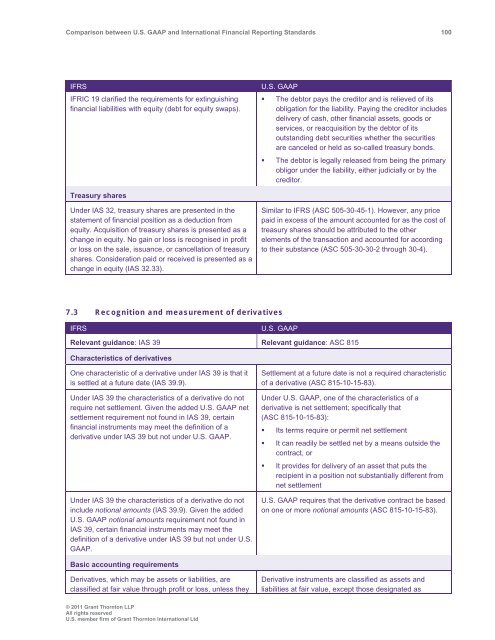Comparison between U.S. GAAP and International ... - Grant Thornton
Comparison between U.S. GAAP and International ... - Grant Thornton
Comparison between U.S. GAAP and International ... - Grant Thornton
Create successful ePaper yourself
Turn your PDF publications into a flip-book with our unique Google optimized e-Paper software.
<strong>Comparison</strong> <strong>between</strong> U.S. <strong>GAAP</strong> <strong>and</strong> <strong>International</strong> Financial Reporting St<strong>and</strong>ards 100<br />
IFRS<br />
IFRIC 19 clarified the requirements for extinguishing<br />
financial liabilities with equity (debt for equity swaps).<br />
U.S. <strong>GAAP</strong><br />
• The debtor pays the creditor <strong>and</strong> is relieved of its<br />
obligation for the liability. Paying the creditor includes<br />
delivery of cash, other financial assets, goods or<br />
services, or reacquisition by the debtor of its<br />
outst<strong>and</strong>ing debt securities whether the securities<br />
are canceled or held as so-called treasury bonds.<br />
• The debtor is legally released from being the primary<br />
obligor under the liability, either judicially or by the<br />
creditor.<br />
Treasury shares<br />
Under IAS 32, treasury shares are presented in the<br />
statement of financial position as a deduction from<br />
equity. Acquisition of treasury shares is presented as a<br />
change in equity. No gain or loss is recognised in profit<br />
or loss on the sale, issuance, or cancellation of treasury<br />
shares. Consideration paid or received is presented as a<br />
change in equity (IAS 32.33).<br />
Similar to IFRS (ASC 505-30-45-1). However, any price<br />
paid in excess of the amount accounted for as the cost of<br />
treasury shares should be attributed to the other<br />
elements of the transaction <strong>and</strong> accounted for according<br />
to their substance (ASC 505-30-30-2 through 30-4).<br />
7.3 Recognition <strong>and</strong> measurement of derivatives<br />
IFRS<br />
U.S. <strong>GAAP</strong><br />
Relevant guidance: IAS 39 Relevant guidance: ASC 815<br />
Characteristics of derivatives<br />
One characteristic of a derivative under IAS 39 is that it<br />
is settled at a future date (IAS 39.9).<br />
Under IAS 39 the characteristics of a derivative do not<br />
require net settlement. Given the added U.S. <strong>GAAP</strong> net<br />
settlement requirement not found in IAS 39, certain<br />
financial instruments may meet the definition of a<br />
derivative under IAS 39 but not under U.S. <strong>GAAP</strong>.<br />
Under IAS 39 the characteristics of a derivative do not<br />
include notional amounts (IAS 39.9). Given the added<br />
U.S. <strong>GAAP</strong> notional amounts requirement not found in<br />
IAS 39, certain financial instruments may meet the<br />
definition of a derivative under IAS 39 but not under U.S.<br />
<strong>GAAP</strong>.<br />
Settlement at a future date is not a required characteristic<br />
of a derivative (ASC 815-10-15-83).<br />
Under U.S. <strong>GAAP</strong>, one of the characteristics of a<br />
derivative is net settlement; specifically that<br />
(ASC 815-10-15-83):<br />
• Its terms require or permit net settlement<br />
• It can readily be settled net by a means outside the<br />
contract, or<br />
• It provides for delivery of an asset that puts the<br />
recipient in a position not substantially different from<br />
net settlement<br />
U.S. <strong>GAAP</strong> requires that the derivative contract be based<br />
on one or more notional amounts (ASC 815-10-15-83).<br />
Basic accounting requirements<br />
Derivatives, which may be assets or liabilities, are<br />
classified at fair value through profit or loss, unless they<br />
Derivative instruments are classified as assets <strong>and</strong><br />
liabilities at fair value, except those designated as<br />
© 2011 <strong>Grant</strong> <strong>Thornton</strong> LLP<br />
All rights reserved<br />
U.S. member firm of <strong>Grant</strong> <strong>Thornton</strong> <strong>International</strong> Ltd
















